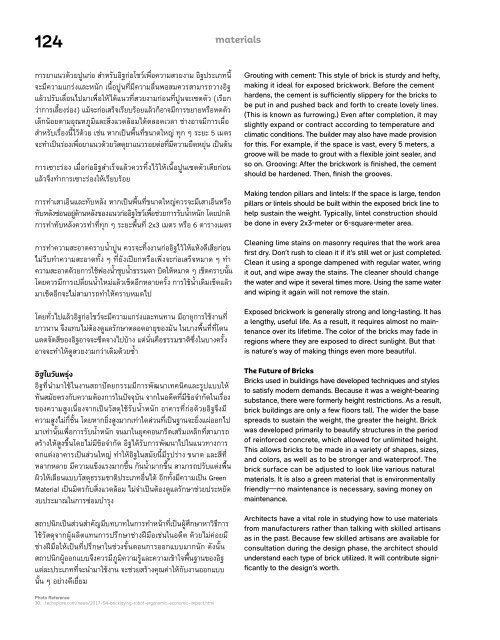ASA Journal 16/2023
You also want an ePaper? Increase the reach of your titles
YUMPU automatically turns print PDFs into web optimized ePapers that Google loves.
124<br />
materials<br />
การยาแนวด้วยปูนก่อ สำาหรับอิฐก่อโชว์เพื่อความสวยงาม อิฐประเภทนี้<br />
จะมีความแกร่งและหนัก เนื้อปูนที่มีความลื่นพอสมควรสามารถวางอิฐ<br />
แล้วปรับเลื่อนไปมาเพื่อให้ได้แนวที่สวยงามก่อนที่ปูนจะเซตตัว (เรียก<br />
ว่าการเลี้ยงร่อง) แม้จะก่อเสร็จเรียบร้อยแล้วก็อาจมีการขยายหรือหดตัว<br />
เล็กน้อยตามอุณหภูมิและสิ่งแวดล้อมได้ตลอดเวลา ช่างอาจมีการเผื่อ<br />
สำาหรับเรื่องนี้ไว้ด้วย เช่น หากเป็นพื้นที่ขนาดใหญ่ ทุก ๆ ระยะ 5 เมตร<br />
จะทำาเป็นร่องเพื่อยาแนวด้วยวัสดุยาแนวรอยต่อที่มีความยืดหยุ่น เป็นต้น<br />
การเซาะร่อง เมื่อก่ออิฐสำาเร็จแล้วควรทิ้งไว้ให้เนื้อปูนเซตตัวเสียก่อน<br />
แล้วจึงทำาการเซาะร่องให้เรียบร้อย<br />
การทำาเสาเอ็นและทับหลัง หากเป็นพื้นที่ขนาดใหญ่ควรจะมีเสาเอ็นหรือ<br />
ทับหลังซ่อนอยู่ด้านหลังของแนวก่ออิฐโชว์เพื่อช่วยการรับน้ำ าหนัก โดยปกติ<br />
การทำาทับหลังควรทำาที่ทุก ๆ ระยะพื้นที่ 2x3 เมตร หรือ 6 ตารางเมตร<br />
การทำาความสะอาดคราบน้ำาปูน ควรจะทิ้งงานก่ออิฐไว้ให้แห้งดีเสียก่อน<br />
ไม่รีบทำาความสะอาดทั้ง ๆ ที่ยังเปียกหรือเพิ่งจะก่อเสร็จหมาด ๆ ทำา<br />
ความสะอาดด้วยการใช้ฟองน้ำาชุบน้ำาธรรมดา บิดให้หมาด ๆ เช็ดคราบนั้น<br />
โดยควรมีการเปลี่ยนน้ำาใหม่แล้วเช็ดอีกหลายครั้ง การใช้น้ำาเดิมเช็ดแล้ว<br />
มาเช็ดอีกจะไม่สามารถทำาให้คราบหมดไป<br />
โดยทั่วไปแล้วอิฐก่อโชว์จะมีความแกร่งและทนทาน มีอายุการใช้งานที่<br />
ยาวนาน จึงแทบไม่ต้องดูแลรักษาตลอดอายุของมัน ในบางพื้นที่ที่โดน<br />
แดดจัดสีของอิฐอาจจะซีดจางไปบ้าง แต่นั่นคือธรรมชาติซึ่งในบางครั้ง<br />
อาจจะทำาให้ดูสวยงามกว่าเดิมด้วยซ้ำา<br />
อิิฐในวัันพัรุ้่ง<br />
อิฐที่นำามาใช้ในงานสถาปัตยกรรมมีการพัฒนาเทคนิคและรูปแบบให้<br />
ทันสมัยตรงกับความต้องการในปัจจุบัน จากในอดีตที่มีข้อจำากัดในเรื่อง<br />
ของความสูงเนื่องจากเป็นวัสดุใช้รับน้ำาหนัก อาคารที่ก่อด้วยอิฐจึงมี<br />
ความสูงไม่กี่ชั้น โดยหากยิ่งสูงมากเท่าใดส่วนที่เป็นฐานจะยิ่งแผ่ออกไป<br />
มาเท่านั้นเพื่อการรับน้ำาหนัก จนมาในยุคคอนกรีตเสริมเหล็กที่สามารถ<br />
สร้างให้สูงขึ้นโดยไม่มีข้อจำากัด อิฐได้รับการพัฒนาไปในแนวทางการ<br />
ตกแต่งอาคารเป็นส่วนใหญ่ ทำาให้อิฐในสมัยนี้มีรูปร่าง ขนาด และสีที่<br />
หลากหลาย มีความแข็งแรงมากขึ้น กันน้ำามากขึ้น สามารถปรับแต่งพื้น<br />
ผิวให้เลียนแบบวัสดุธรรมชาติประเภทอื่นได้ อีกทั้งมีความเป็น Green<br />
Material เป็นมิตรกับสิ่งแวดล้อม ไม่จำาเป็นต้องดูแลรักษาช่วยประหยัด<br />
งบประมาณในการซ่อมบำารุง<br />
สถาปนิกเป็นส่วนสำาคัญมีบทบาทในการทำาหน้าที่เป็นผู้ศึกษาหาวิธีการ<br />
ใช้วัสดุจากผู้ผลิตแทนการปรึกษาช่างฝีมือเช่นในอดีต ด้วยไม่ค่อยมี<br />
ช่างฝีมือให้เป็นที่ปรึกษาในช่วงขั้นตอนการออกแบบมากนัก ดังนั้น<br />
สถาปนิกผู้ออกแบบจึงควรมีภูมิความรู้และความเข้าใจพื้นฐานของอิฐ<br />
แต่ละประเภทที่จะนำามาใช้งาน จะช่วยสร้างคุณค่าให้กับงานออกแบบ<br />
นั้น ๆ อย่างดีเยี่ยม<br />
Grouting with cement: This style of brick is sturdy and hefty,<br />
making it ideal for exposed brickwork. Before the cement<br />
hardens, the cement is sufficiently slippery for the bricks to<br />
be put in and pushed back and forth to create lovely lines.<br />
(This is known as furrowing.) Even after completion, it may<br />
slightly expand or contract according to temperature and<br />
climatic conditions. The builder may also have made provision<br />
for this. For example, if the space is vast, every 5 meters, a<br />
groove will be made to grout with a flexible joint sealer, and<br />
so on. Grooving: After the brickwork is finished, the cement<br />
should be hardened. Then, finish the grooves.<br />
Making tendon pillars and lintels: If the space is large, tendon<br />
pillars or lintels should be built within the exposed brick line to<br />
help sustain the weight. Typically, lintel construction should<br />
be done in every 2x3-meter or 6-square-meter area.<br />
Cleaning lime stains on masonry requires that the work area<br />
first dry. Don’t rush to clean it if it’s still wet or just completed.<br />
Clean it using a sponge dampened with regular water, wring<br />
it out, and wipe away the stains. The cleaner should change<br />
the water and wipe it several times more. Using the same water<br />
and wiping it again will not remove the stain.<br />
Exposed brickwork is generally strong and long-lasting. It has<br />
a lengthy, useful life. As a result, it requires almost no maintenance<br />
over its lifetime. The color of the bricks may fade in<br />
regions where they are exposed to direct sunlight. But that<br />
is nature’s way of making things even more beautiful.<br />
The Future of Bricks<br />
Bricks used in buildings have developed techniques and styles<br />
to satisfy modern demands. Because it was a weight-bearing<br />
substance, there were formerly height restrictions. As a result,<br />
brick buildings are only a few floors tall. The wider the base<br />
spreads to sustain the weight, the greater the height. Brick<br />
was developed primarily to beautify structures in the period<br />
of reinforced concrete, which allowed for unlimited height.<br />
This allows bricks to be made in a variety of shapes, sizes,<br />
and colors, as well as to be stronger and waterproof. The<br />
brick surface can be adjusted to look like various natural<br />
materials. It is also a green material that is environmentally<br />
friendly—no maintenance is necessary, saving money on<br />
maintenance.<br />
Architects have a vital role in studying how to use materials<br />
from manufacturers rather than talking with skilled artisans<br />
as in the past. Because few skilled artisans are available for<br />
consultation during the design phase, the architect should<br />
understand each type of brick utilized. It will contribute significantly<br />
to the design’s worth.<br />
Photo Reference<br />
30. techxplore.com/news/2017-04-bricklaying-robot-ergonomic-economic-impact.html

















